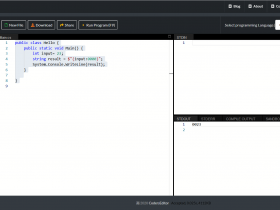C# Program to Find the Largest Prime Factor of a Number
This C# program calculates and displays the largest prime factor of a given positive integer. A prime factor is a prime number that divides another number without leaving a remainder.
Problem Statement
Given a positive integer N, your task is to find and return the largest prime factor of N.
C# Program to Find the Largest Prime Factor of a Number
using System;
class Program
{
static bool IsPrime(long number)
{
if (number <= 1)
return false;
if (number <= 3)
return true;
if (number % 2 == 0 || number % 3 == 0)
return false;
for (long i = 5; i * i <= number; i += 6)
{
if (number % i == 0 || number % (i + 2) == 0)
return false;
}
return true;
}
static long FindLargestPrimeFactor(long number)
{
long largestPrimeFactor = 0;
while (number % 2 == 0)
{
largestPrimeFactor = 2;
number /= 2;
}
for (long i = 3; i <= Math.Sqrt(number); i += 2)
{
while (number % i == 0)
{
largestPrimeFactor = i;
number /= i;
}
}
if (number > 2)
largestPrimeFactor = number;
return largestPrimeFactor;
}
static void Main(string[] args)
{
Console.Write("Enter a number: ");
long number = long.Parse(Console.ReadLine());
long largestPrimeFactor = FindLargestPrimeFactor(number);
if (largestPrimeFactor == 0)
Console.WriteLine("No prime factors found.");
else
Console.WriteLine($"The largest prime factor of {number} is: {largestPrimeFactor}");
}
}
How it Works
- Initialization: Start with the input integer
Nthat you want to find the largest prime factor of. - Divide by 2 (if possible): Check if
Nis divisible by 2 (the smallest prime number). If it is, repeatedly divideNby 2 until it’s no longer divisible by 2. This step is used to remove all the factors of 2 fromN. - Iterate from 3 onward: Start a loop from 3, and for each number
iin the loop, do the following:a. Check ifNis divisible byi. If it is, divideNbyi.b. IfNis not divisible byi, incrementiby 2. This is because we only need to check odd numbers as potential factors since even numbers greater than 2 cannot be prime.c. Repeat steps (a) and (b) untilNbecomes 1 or untilibecomes greater than the square root of the remainingN. - Result: The largest prime factor of the original input
Nis the last value ofithat was used in the loop.
Here’s a step-by-step example of how this algorithm works for finding the largest prime factor of 60:
- Start with
N = 60. - Divide by 2:
N = 30. - Divide by 2 again:
N = 15. - Start looping from 3.
- Check if
Nis divisible by 3: It is, so divide by 3:N = 5. - The loop continues to the next value, which is 5.
- Check if
Nis divisible by 5: It is, so divide by 5:N = 1. - The loop ends because
Nis now 1.
- Check if
- The largest prime factor found during the process is 5.
Input/ Output






Leave a Review